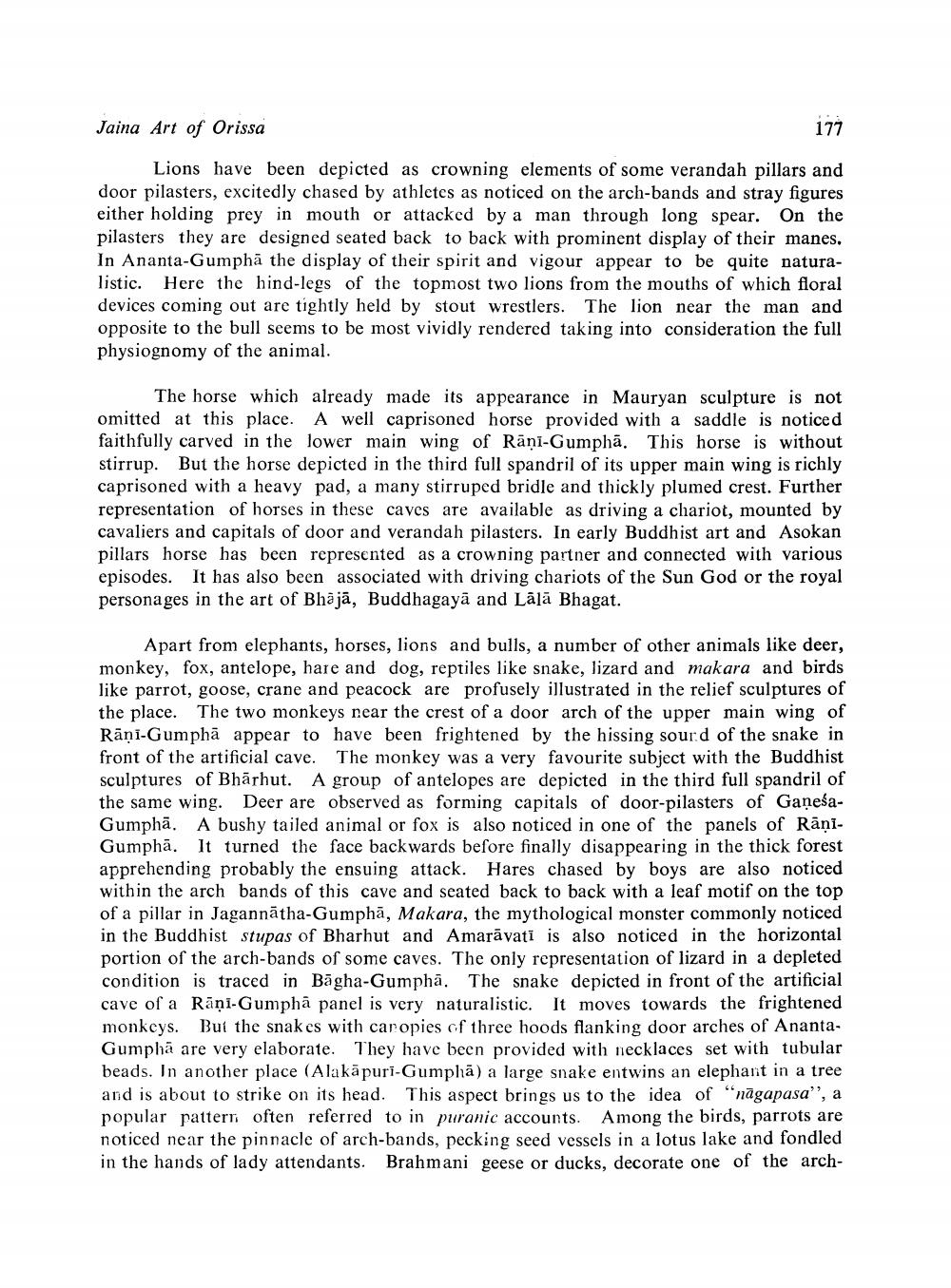________________
Jaina Art of Orissa
Lions have been depicted as crowning elements of some verandah pillars and door pilasters, excitedly chased by athletes as noticed on the arch-bands and stray figures either holding prey in mouth or attacked by a man through long spear. On the pilasters they are designed seated back to back with prominent display of their manes. In Ananta-Gumpha the display of their spirit and vigour appear to be quite naturalistic. Here the hind-legs of the topmost two lions from the mouths of which floral devices coming out are tightly held by stout wrestlers. The lion near the man and opposite to the bull seems to be most vividly rendered taking into consideration the full physiognomy of the animal.
177
The horse which already made its appearance in Mauryan sculpture is not omitted at this place. A well caprisoned horse provided with a saddle is noticed faithfully carved in the lower main wing of Räni-Gumpha. This horse is without stirrup. But the horse depicted in the third full spandril of its upper main wing is richly caprisoned with a heavy pad, a many stirruped bridle and thickly plumed crest. Further representation of horses in these caves are available as driving a chariot, mounted by cavaliers and capitals of door and verandah pilasters. In early Buddhist art and Asokan pillars horse has been represented as a crowning partner and connected with various episodes. It has also been associated with driving chariots of the Sun God or the royal personages in the art of Bhaja, Buddhagaya and Lâlā Bhagat.
Apart from elephants, horses, lions and bulls, a number of other animals like deer, monkey, fox, antelope, hare and dog, reptiles like snake, lizard and makara and birds. like parrot, goose, crane and peacock are profusely illustrated in the relief sculptures of the place. The two monkeys near the crest of a door arch of the upper main wing of Rāņi-Gumpha appear to have been frightened by the hissing sourd of the snake in front of the artificial cave. The monkey was a very favourite subject with the Buddhist sculptures of Bharhut. A group of antelopes are depicted in the third full spandril of the same wing. Deer are observed as forming capitals of door-pilasters of GaṇeśaGumpha. A bushy tailed animal or fox is also noticed in one of the panels of RaniGumpha. It turned the face backwards before finally disappearing in the thick forest apprehending probably the ensuing attack. Hares chased by boys are also noticed within the arch bands of this cave and seated back to back with a leaf motif on the top of a pillar in Jagannatha-Gumpha, Makara, the mythological monster commonly noticed in the Buddhist stupas of Bharhut and Amaravati is also noticed in the horizontal portion of the arch-bands of some caves. The only representation of lizard in a depleted condition is traced in Bagha-Gumphã. The snake depicted in front of the artificial cave of a Rāņi-Gumpha panel is very naturalistic. It moves towards the frightened monkeys. But the snakes with canopies of three hoods flanking door arches of AnantaGumpha are very elaborate. They have been provided with necklaces set with tubular beads. In another place (Alakapuri-Gumpha) a large snake entwins an elephant in a tree and is about to strike on its head. This aspect brings us to the idea of "nagapasa", a popular pattern often referred to in puranic accounts. Among the birds, parrots are noticed near the pinnacle of arch-bands, pecking seed vessels in a lotus lake and fondled in the hands of lady attendants. Brahmani geese or ducks, decorate one of the arch




